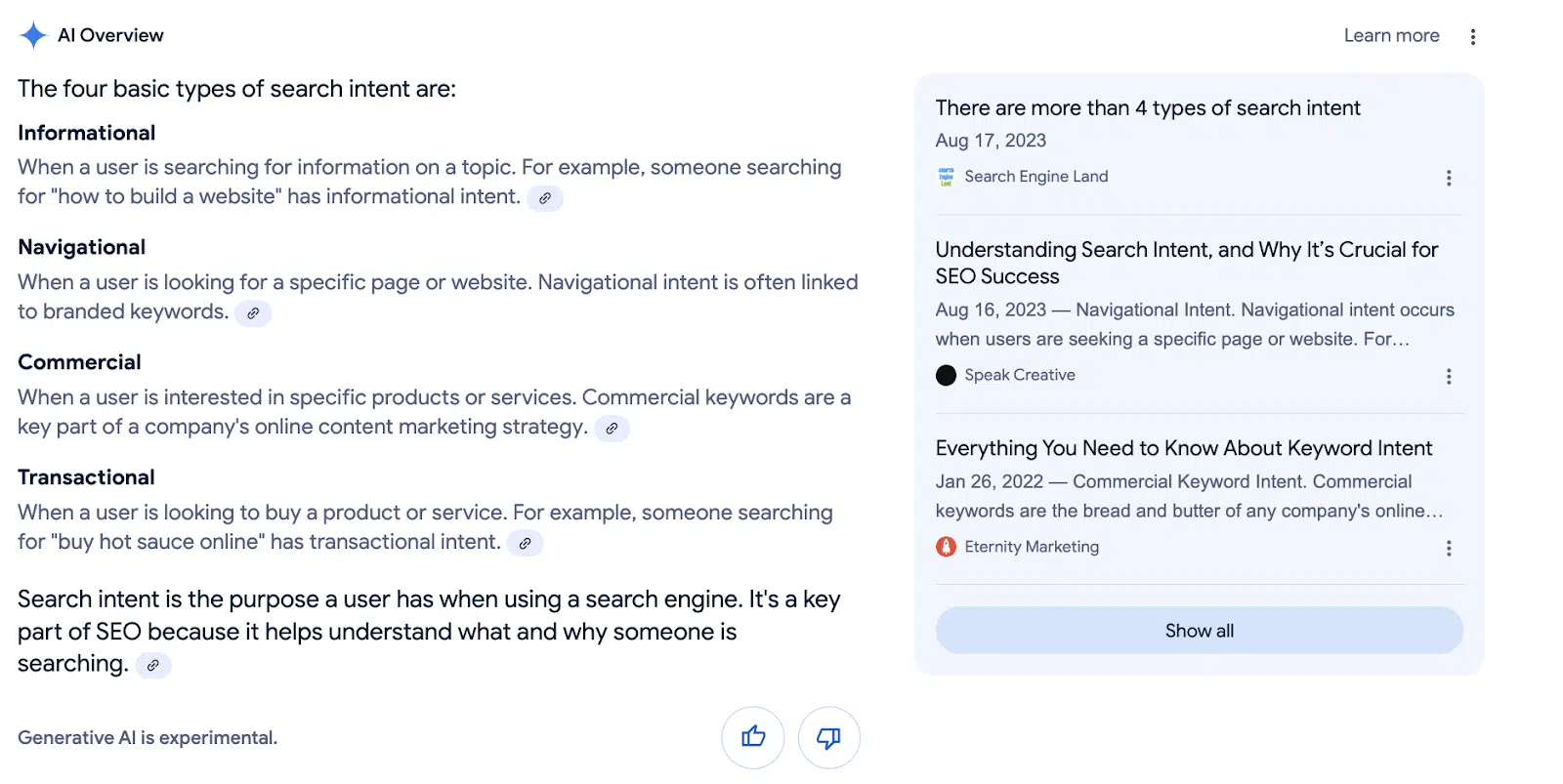Google AI Overviews: Everything you need to know
Google AI Overviews now dominate the SERPs. Learn strategies to adapt, rank, and thrive with AI-focused, intent-driven content optimization.
Google AI Overviews are reshaping search results, taking over prime real estate on the SERPs. So how can you secure a spot? Here’s what we’ve learned – and how you can adapt.
Capturing the top spot in Google Search with AI Overviews
Google AI Overviews are changing how search results appear, synthesizing answers from top content to provide users with quick, clear responses.
To secure a spot in this prime SERP real estate, success now depends on structuring content to align with how people interact with AI – using natural language, direct questions, and a conversational style.
This approach increases your chances of appearing in AI Overviews, delivers a better user experience, and drives stronger search engine rankings.

My agency has spent 6–12 months running experiments to capture positions in Google AI Overviews.
We’ve found that generative AI favors step-by-step, high-level, process-oriented content for top results.
In the competitive B2B sector where we work, top-performing websites have abandoned the “inside baseball” approach.
They now focus on conversational language, delivering clear, direct answers that explain both the implementation steps and the strategic rationale behind each solution.
4 steps to rank in the AI Overviews
Based on our findings, securing a spot in Google AI Overviews requires a strategic, intent-driven approach. Here are four actionable steps to optimize your content and capture top positions.
1. Segment by intent
Start your editorial planning for AI-focused questions and keywords by segmenting them into four types of user intent:
- Informational.
- Transactional.
- Navigational.
- Commercial.
Optimize for intent first, then focus on crafting the highest-quality answer for AI Overviews.
Our findings show that AI Overviews tend to favor content with informational intent more often than not.

2. Figure out what your competitors are working on
Analyze the jargon your industry competitors use and seize these clear opportunities to optimize your content.
Develop a targeted content strategy to position brands as a leading competitor in this space and showcase their capabilities and solutions.
The best-performing content:
- Includes clear and direct definitions of the subject matter.
- Explores different dimensions of a topic.
- Differentiates itself by the writer/publisher/company’s direct experience.
- Emphasizes the important value proposition (or benefits) of the product or service.
3. Determine the contextual value of competing results
- Dimensions / measurable breakdown
- Present the steps for the searchers on how and the cost associated with each step in the process or the contextual measurements of ROI on the product or services.
- Break down the benefits of “subject matter” with dimensions that can be tracked, why those metrics add value to the business, and how to track them.
4. Identify the types of content in the AI Overviews
- Use cases/direct experience
- Enhance case study content to incorporate definitions of the work that can easily answer common search queries and outline the work while describing how it works.
- Optimize content to incorporate definitions of the types of “the subject matter” and “affiliated search terms or question” options that can easily answer common search queries rather than outlining the work without describing how it works.
- Best practices/standards
- The content ranking in AI Overviews lists the best practices and the process for executing or better understanding the subject matter or query.
Frequently asked questions on AI Overviews
What triggers an AI Overview?
An AI Overview is triggered when Google’s algorithm determines that the best answer to a query is a generative response.
What is the impact on SEO?
While AI Overviews do not directly impact rankings, they can impact your SERP visibility and organic traffic.
It’s important to optimize your page links, content, and citations to provide the best answers for your target queries and audiences.
Where do I find the links?
On desktop, AI Overview links are displayed on the right side of the results. On mobile, you can find them by tapping the site icons in the upper-right corner of the search results.
How do AI Overviews differ across industries?
The value of AI Overviews varies based on the context and intent of industry-specific queries. For example:
- In the software industry, AI Overviews often summarize ROI-driven, informational searches.
- In manufacturing, AI Overviews tend to focus on “capabilities” and process-related content.
- For consumer brands, AI Overviews frequently highlight PR-related links.
The future of search: Google’s AI expansion
Google is going all in on AI. Alphabet’s 2024 Q3 earnings report highlights the rollout of AI Overviews and their monthly expansion to all users.

Paid search is also evolving with generative AI, as AI Overview ads are now available for relevant queries on mobile devices in the U.S.
Winning in the age of AI Overviews
To capture AI Overviews, focus on using conversational language.
The fusion of AI and search requires SEO practitioners to master conversational search patterns, similar to how users phrase queries with AI assistants.
Success now depends on understanding both natural language processing and how users ask questions.
As search engine algorithms evolve rapidly, it’s crucial to continuously test new optimization tactics. Staying ahead of the curve ensures your organic traffic and click-through rates remain strong.
Understanding and adapting to these AI-driven changes is now essential for adding creative value in a world shaped by AI.
Contributing authors are invited to create content for Search Engine Land and are chosen for their expertise and contribution to the search community. Our contributors work under the oversight of the editorial staff and contributions are checked for quality and relevance to our readers. Search Engine Land is owned by Semrush. Contributor was not asked to make any direct or indirect mentions of Semrush. The opinions they express are their own.


